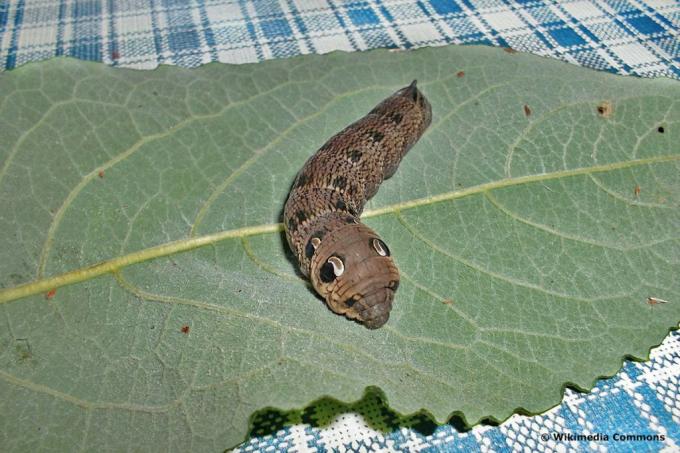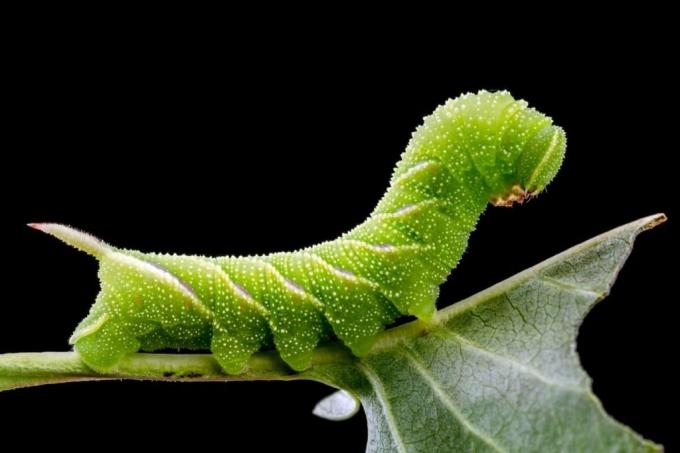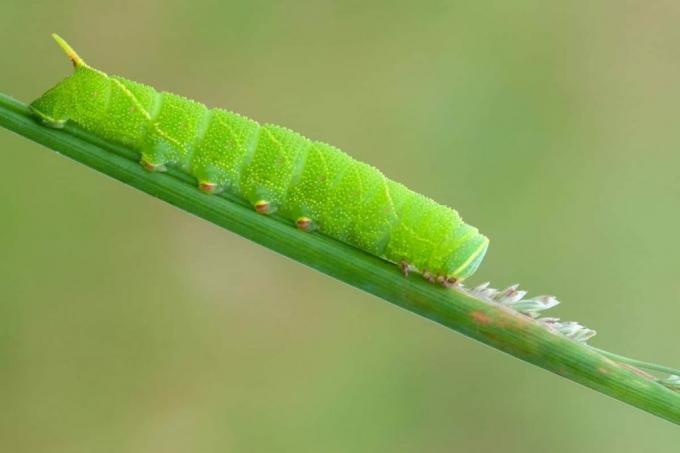
table of contents
- Which caterpillars have a horn?
- What is it?
- Caterpillar species with horn from A to K
- Caterpillar species with horn from L to P
- frequently asked Questions
Where adult moths are usually quite easy to identify, it becomes more difficult with their caterpillars. Fortunately, distinctive "badges" help with identification. We show well-known caterpillars with horn.
In a nutshell
- Horn does not sit on the head, but on the rearmost segment of the caterpillars
- so-called "anal horn" is typical for the family of hawkmoths (Sphingidae)
- depending on the age of the caterpillars, the size and color of the horn can vary greatly
Which caterpillars have a horn?
Horned caterpillars are a characteristic feature of the so-called Phingidae, in German the "swarmers". This family of species of butterflies is distributed almost worldwide and is very well known. Many of the types listed below will surely sound familiar to you.
20 species of the family are native to Germany, but only 8 species are widespread and are common. On the other hand, around 1,200 variants of the enthusiasts are known worldwide.
What is it?
Contrary to popular belief that the outgrowth is right on the legendary unicorn Head, the caterpillars are actually outgrowths at the rearmost, the eighth segment of the Body. One therefore speaks of the so-called anal horn. A real function of the horn has been little researched to this day and is therefore not known.
Note: Although each butterfly species has its own expression of this horn, size, shape and color also vary within a species depending on the age of the caterpillar.
Caterpillar species with horn from A to K
Evening peacock butterfly (Smerinthus ocellatus)

- blue-green to yellow-green color
- white spots all over the body
- yellow diagonal stripes on the side
- lighter top
- Size: up to 80 millimeters
- Horn: light blue
- Occurrence: July to September
- Environment: willows, poplars, birches, apple and other fruit trees
Bumble bee (Hemaris fuciformis)

- first light yellow, later strong green
- light longitudinal lines on the sides
- countless bright point warts all over the body
- laterally red spots
- Size: 35 to 40 millimeters
- Horn: initially dark, later red base with brown tip
- Occurrence: June to early August
- Environment: honeysuckles, forest honeysuckle, bedstraws, deutzias, snowberries, widow flowers
Pine hawk (Sphinx pinastri)

- initially yellow, later green basic color
- six light yellow longitudinal lines from the first moult
- beige to gray-brown head
- Size: 75 to 80 millimeters
- Horn: dark to black, split at the end
- Appear: July until September
- Environment: pine, spruce, cedar, larch, Douglas fir
Little Wine Hawk (Deilephila porcellus)

- green, later brown basic color
- bright eye spots on the second and third segments
- Size: up to 70 millimeters
- Horn: weakly pronounced as a small hump
- Occurrence: July to August
- Environment: dry grass, roadsides, railway embankments, on bed weeds and willowherb
Caterpillar species with horn from L to P
Privet hawk (Sphinx ligustri)

- bright green color
- seven white-pink to white-violet colored side stripes
- countless yellow dots all over the body
- Size: up to 100 millimeters
- Horn: light at the base, darker at the tip
- Occurrence: July to early September
- Surroundings: privet, lilac, ash, berry trees, honeysuckle, snowberries, spear bushes
Note: Although feared by many gardeners, the privet hawk usually only occurs in such small numbers that it does not pose a threat to the infected bushes.
Linden Hawk (Mimas tiliae)

- initially light green, later green to blue-green color
- clear yellow diagonal stripes on the sides
- almost triangular head capsule
- countless yellow tubercles all over the body
- shortly before pupation: upper side gray-brown, underside pale green-violet
- Size: 55 to 65 millimeters
- Horn: blue or purple, anal plate red to reddish yellow
- Appear: June until August
- Environment: linden, birch, cherries
Middle Wine Hawk (Deilephila elpenor)

- initially green, later brown to brown-black
- two distinctive eye spots in the front third
- Size: up to 80 millimeters
- Horn: dark, long and pointed
- Occurrence: mid-June to August
- Environment: fireweed, spring herbs, fuchsias, purple loosestrife, evening primrose
Poplar Hawk (Laothoe populi)

- bright green basic color
- darker diagonal stripes on the sides
- tiny bright tubercles all over the body
- lateral line of dark dots
- Size: around 80 millimeters
- Horn: yellow and rather inconspicuous, bluish color at the base
- Occurrence: July and August
- Environment: poplars, willows, fruit trees
frequently asked Questions
Although signal colors and distinctive markings often indicate toxicity, the caterpillars are completely harmless. As a very widespread species, they are on the menu of countless native songbirds, for example.
It is assumed that the horn's signaling effect is intended to deter predators and can be interpreted as a signal for poison, for example. One speaks of "mimicry" because a non-existent property is faked. Further functions are not yet known or researched.
So far, it is not known that caterpillars have added any function to the horn in any way. Stinging with the often pointed appendage is also not possible. The main function is probably actually the signaling effect



